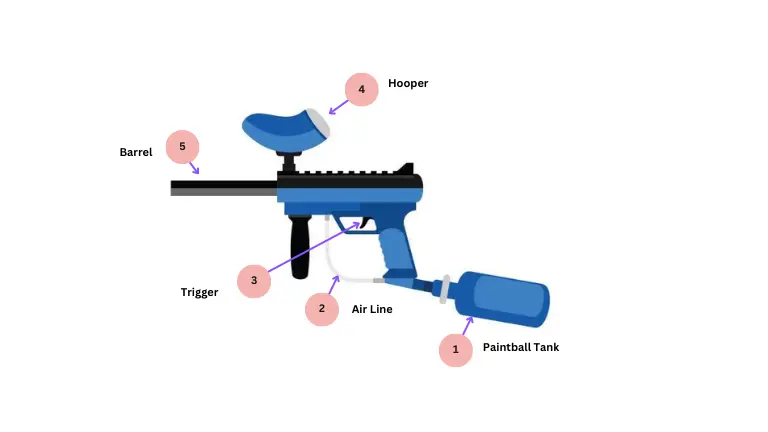The majority of paintball beginners struggle with their guns. Assembling, maintaining, and upgrading markers can be challenging without enough knowledge of their operation. So, how does a paintball gun work? In this article, we will take a closer look at the paintball gun, so if this is what you are looking for, you’ve come to the right place.
You will find many companies that manufacture paintball markers. These guns share almost identical inner workings regardless of the outer appearance.
Read on to learn more about these guns and their workings.

What are Basic Paintball Gun Parts?
Before we get into the workings of paintball markers, let’s first talk about gun parts. It does not matter what type of paintball gun you have; these parts are the same. A paintball gun has five major parts: a CO₂ tank, an airline, a trigger, a barrel, and a hopper. Check out how each part contributes to its functionality:
Paintball Tank
Paintball markers are attached to gas cartridges. These paintball tanks supply pressurized gas essential for propelling paintballs from the barrel. The paintball gun uses two types of tanks: CO₂ and compressed air (HPA). Most high-end paintball guns have HPA instead of CO₂. The tank is connected to the marker’s Air Source Adapter (ASA), located at the bottom of the grip.
Airline
From the ASA, the high-pressure gasses enter the gas line, which is further connected to the valve/chamber located next to the trigger and barrel. This chamber stores air and doesn’t allow it to escape.
Trigger
Pressing the trigger will fire the paintball. Once the trigger is pulled, pressurized gases from the valve flow toward the barrel, ejecting the paintballs. It also regulates the rear hammer/bolt movement. The trigger system varies from gun to gun. High-end electronic paintball guns have more advanced trigger mechanisms that ensure a higher firing rate.
Hopper
Hooper or feeder is located at the top of a paintball gun, just above the barrel. Unlike real guns, which have magazines for loading bullets, paintball markers have hoppers that load paintballs into the gun.
Barrel
The barrel is the place where paintballs are loaded. The gas cylinder provides the push that ejects paintballs at high velocity. The barrel of the gun is attached to the front.

How Do Paintball Guns Work?
Understanding paintball gun operation will allow you to use guns more effectively. Regardless of the model, paintball’s basic working remains the same. For the purpose of this article, I will demonstrate the working Tippmann A5 paintball marker.
Here is the whole Tippmann A5 paintball gun operation:
Air Delivery to Chamber
The gas cartridge is connected to the ASA. From here, the air is taken towards chamber 1 through the gas line. Air enters the tombstone through the ASA plug, which funnels the air as it enters the valve. Inside the valve, the plunger seals against the valve seat, preventing air from moving any further. Upon pulling the trigger, the hammer will push the pressurized air toward the barrel.
Trigger, Sear, and Hammer
The trigger system of the Tippmann Tipx gun is connected to the sear, which blocks the hammer or rear bolt. When you squeeze the trigger, it rotates around a pin and raises the front of the trigger sear.
In doing so, the sear frees the hammer, which results in hammer advancement towards the power tube under the force of the drive spring. The sear resets itself and waits for the hammer to return to its original position.
As the hammer is connected to the front bolt through the linkage arm, it also pushes the front bolt to move forward. Consequently, the paintball is forced into the detent by the front bolt, which folds down to allow it to pass. Paintballs eventually reach the breech end of the barrel.
Paintball Expulsion
The drive spring pushes the hammer that enters the power tube, creating an airtight seal. The rear bolt continues to move forward until it strikes the plunger valve pin. As the plunger leaves its position and moves inside the valve, it allows the air to escape, traveling in two directions.
First, it travels backward and pushes the hammer and the whole assembly to go back to their original position. This is also known as blowback gas. I will discuss this in the next section.
In addition to this, air travels on both sides of the valve to power the Cyclone and response trigger. You can call this propellant gas that moves opposite the direction of the blowback gas.
Alternatively, the pressurized gas can move forward through four grooves outside the valve. As it passes through the narrow power tube extension where the front bolt resides, it pushes the paintball through the barrel.
Reset
After the firing of the paintball, the marker starts the resetting mechanism. The blowback gas keeps pushing the hammer, linkage arm, front bolt, and valve plunger back to their original positions. The valve plunger restricts the airflow by restoring the seal again once it reaches the valve seat again.
The hammer continues its backward journey by blowback gas pressure and compresses the drive spring. As soon as the hammer passes over the sear, it hits the sealing ring on the end cap. The hammer is pushed forward again until the sear catches it and is reset. Now the marker is ready to fire again.

Conclusion
To get the most out of your paintball gun, you need to understand how it works. The purpose of this article was to give you an overview of the sophisticated mechanism that takes place under the hood whenever you shoot a paintball. I hope this will help you fix any shooting problems you might encounter while using your paintball marker.

